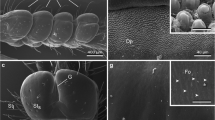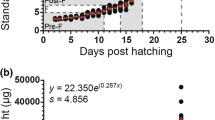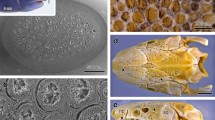Summary
Studies were carried out to identify the route by which macromolecules and large volumes of fluid traverse the skin of terrestrial gastropods. Electron micrographs of the skin of the banana slug Ariolimax columbianus demonstrated that carbon particles can enter large, specialized cells and pass thence to the exterior. These cells, which are termed channel cells, range up to 500 μm in length; they reach from the external surface of the skin to deep within the subepithelial interstitium. At the light-microscope level they show a large central channel or reservoir apparently filled with homogeneous fluid; after injection of ink into the body cavity this central channel becomes ink-filled. Electron micrographs show cisternae of the smooth endoplasmic reticulum, opening from the cell surface and occasionally traversing the entire cytoplasmic layer. The neurohormone arginine vasotocin stimulates fluid and particle movement through the channel cell; this response is inhibited by norepinephrine. Fluid output is dependent on the presence of a transwall hydrostatic pressure gradient of about 7 torr or above, as well as on activation of the channel cells.
Similar content being viewed by others
References
Burton RF (1965) Relationship between the cation contents of slime and blood in the snail Helix pomatia L. Comp Biochem Physiol 15:339–345
Campion M (1961) The structure and function of the cutaneous glands in Helix aspersa. Q J Micros Sci 102:195–216
Carvounis CP, Franki N, Levine SD, Hays RM (1979) Membrane pathways for water and solutes in the toad bladder. I. Independent activation of water and urea transport. J Membr Biol 49:253–268
Deyrup-Olsen I, Martin AW (1982) Surface exudation in terrestrial slugs. Comp Biochem Physiol 72C: 45–51
Herfs A (1922) Studien von den Hautdrüsen der Land und Süsswassergastropoden. Arch Mikr Anat 96:1–38
Machin J (1964) The evaporation of water from Helix aspersa. I. The nature of the evaporating surface. J Exp Biol 41:159–769
Martin AW, Deyrup-Olsen I (1982) Blood venting through the pneumostome in terrestrial slugs. Comp Biochem Physiol 72C:53–58
Martin AW, Luchtel DL, Deyrup-Olsen I (1982) Mechanism of action of arginine-vasotocin and lysine-vasotocin on surface exudation by a slug body wall. Physiologist 25:298
Plummer JM (1966) Collagen formation in Achatinidae associated with a specific cell type. Proc Malacol Soc 37:189–198
Reger JF (1973) A fine structure study on hemocyanin formation in the slug Limax sp. J Ultrastruct Res 43:377–387
Roach DK (1963) Analysis of haemolymph of Arion ater L. J Exp Biol 40:612–623
Roth H (1929) Zur Kenntnis des Epithels und der Entwicklung der einzelligen Hautdrüsen. Z Wiss Mikr 135:357–427
Ruddell CL, Wellings SR (1971) The ultrastructure of the oyster brown cell, a cell with a fenestrated plasma membrane. Z Zellforsch 120:17–28
Sawyer WH, Deyrup-Olsen I, Martin AW (1983) Immunological and biological characteristics of the vasotocin-like activity in the head ganglia of gastropod molluscs. Gen Comp Endocrinol. In press
Simkiss K, Wilbur KM (1977) The molluscan epidermis and its secretion. Symp Zool Soc Lond 39:35–76
Skeldings JM, Newell PF (1975) On the functions of the pore cells in the connective tissue of terrestrial pulmonate molluscs. Cell Tissue Res 156:381–390
Sminia T (1972) Structure and function of blood and connective tissue cells of the freshwater pulmonate Lymnaea stagnalis studied by electron microscopy and enzyme histochemistry. Z Zellforsch 130:497–526
Wolburg-Buchholz K (1972) Blasenzellen in Bindegewebe des Schlundrings von Cepaea nemoralis L. (Gastropoda, Stylommatophora) II Aufnahme und Speicherung von Ferritin. Z Zellforsch 130:262–278
Wondrak G (1968) Die exoepithelialen Schleimdrüsenzellen von Arion empiricorum (Fér.) Z Zellforsch 76:287–294
Zill R (1924) Die subepithelialen Hautdrüsen von Helix pomatia und einigen anderen Landgehäuseschnecken. Z Anat 71:1–40
Author information
Authors and Affiliations
Rights and permissions
About this article
Cite this article
Luchtel, D.L., Martin, A.W. & Deyrup-Olsen, I. The channel cell of the terrestrial slug Ariolimax columbianus (Stylommatophora, Arionidae). Cell Tissue Res. 235, 143–151 (1984). https://doi.org/10.1007/BF00213734
Accepted:
Issue Date:
DOI: https://doi.org/10.1007/BF00213734




